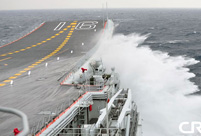 'Jin' named the word of the year by cross-strait netizens
'Jin' named the word of the year by cross-strait netizens Chinese scientific expedition goes to build new Antarctica station
Chinese scientific expedition goes to build new Antarctica station
 Chinese naval escort fleet conducts replenishment in Indian Ocean
Chinese naval escort fleet conducts replenishment in Indian Ocean 17th joint patrol of Mekong River to start
17th joint patrol of Mekong River to start China's moon rover, lander photograph each other
China's moon rover, lander photograph each other Teaming up against polluters
Teaming up against polluters
 |
| Street statues in Wuhan, Hubei province, on Dec 25 reflect ongoing public concern with PM2.5 pollution. Liu Dajia / For China Daily |
Despite pledges in the last year to fight pollution, Beijing saw barely any improvement in air quality in 2013.
The intensity of major air pollutants remained much the same in 2013 as they were in the previous year, figures released by the Beijing Environmental Protection Bureau on Thursday indicate.
PM2.5, airborne particulate matter smaller than 2.5 micrometers in diameter, was 2.5 times the national standard, it said.
Authorities began to monitor and publish PM2.5 levels in 2013.
"It's a long process to fight the capital's pollution," Fang Li, spokesman for the bureau, said at a news conference on Thursday.
The PM2.5 reading in 2013 was on average 89.5 micrograms per cubic meter. By comparison, the national standard stands at 35 micrograms per cubic meter.
PM2.5 was found to be the major pollutant — accounting for 77.8 percent — on most smoggy days.
Southern Beijing saw much higher PM2.5 readings in 2013 compared with the north.
As for other major air pollutants, the figures showed a slight reduction in the average intensity of sulfur dioxide and PM10 compared with 2012, but nitrogen dioxide increased by 7 percent year-on-year.
The most heavily polluted days were in January 2013, seriously affecting the year's average reading, said Yu Jianhua, a Beijing Environmental Protection Bureau official.
Zhang Dawei, head of the Beijing Environmental Monitoring Center, said that compared with 1998, the intensity of sulfur dioxide declined by 78 percent, nitrogen dioxide by 24 percent and PM10 by 43 percent.
But considering the rising number of automobiles and the increasing energy consumption in all walks of life, Beijing's goal to reduce PM2.5 concentration to 60 micrograms per cubic meter by the end of 2017 — down 25 percent from 2012 — will "remain very challenging", he said.
"The stricter standards require the capital to come up with more stringent measures," he said.
A report released by the Chinese Academy of Sciences on Monday said secondary inorganic aerosols — fine, solid particles comprising sulfate and nitrate that result from a photochemical reaction — are responsible for 26 percent of Beijing's PM2.5, whereas vehicle emissions account for about 4 percent.
However, the bureau contradicted that report on Thursday, saying that automobile emissions are still the major source of PM2.5 in Beijing.
Figures from the bureau reveal that automobile emissions account for 22.2 percent of PM2.5 concentration, after pollution from neighboring provinces (24.5 percent). It is followed by coal consumption (16.7 percent), industrial pollution (16.3 percent) and dust (15.8 percent).
 Commemorate 120th birth anniversary of Mao Zedong
Commemorate 120th birth anniversary of Mao Zedong Female soldiers of PLA Marine Corps in training
Female soldiers of PLA Marine Corps in training Chinese cities to have a very grey Christmas as smog persists
Chinese cities to have a very grey Christmas as smog persists China and U.S. - the national image in each other’s eyes
China and U.S. - the national image in each other’s eyes The Liaoning's combat capability tested in sea trial
The Liaoning's combat capability tested in sea trial Chinese pole dancing team show their moves in snow
Chinese pole dancing team show their moves in snow Rime scenery in Mount Huangshan
Rime scenery in Mount Huangshan Ronnie O'Sullivan: My children mean the world to me
Ronnie O'Sullivan: My children mean the world to me Shopping in Hong Kong: a different picture
Shopping in Hong Kong: a different picture Yearender: Animals' life in 2013
Yearender: Animals' life in 2013 Hello 2014 - Chinese greet the New Year
Hello 2014 - Chinese greet the New Year Chocolate 'Terracotta Warriors' appear
Chocolate 'Terracotta Warriors' appear  Top 10 domestic news of 2013
Top 10 domestic news of 2013 Red crabs begin annual migrations in Australia
Red crabs begin annual migrations in Australia Artifacts retrieved from West Zhou Dynasty
Artifacts retrieved from West Zhou DynastyDay|Week|Month